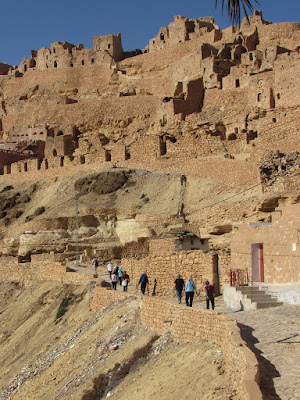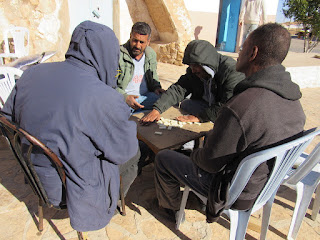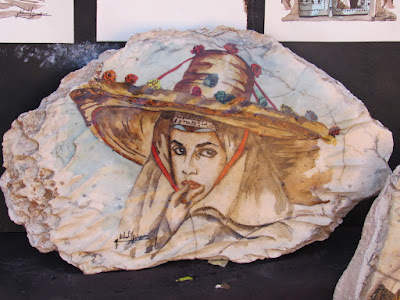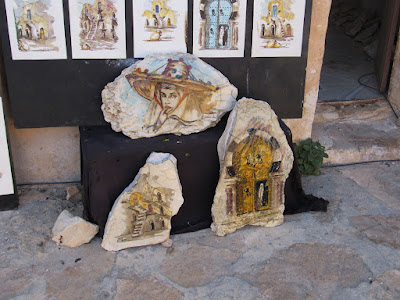Today we drove through the rocky desert with its high yellow and gray cliffs, low valleys, and sinuous roads of southern Tunisia through the lands of North Africa's native peoples, the Berbers. The Berbers are an ethnic group of people with white skin and dark hair and eyes. They were seen by others as barbarians despite their well-developed culture. They established settlements unlike the Bedouins and nomadic tribes who roamed the desert with their camels and goats and lived in tents.
The Berbers lived in what is referred to as "the Maghreb", which the Arabs referred to as the "lands west of Arabia". The Maghreb extends from Libya west to Morocco and southward to Mauritania. The Berbers built ksars, which consisted of attached houses, a fortified communal granary, a mosque, hammam, oven, and shops. Their building materials were usually adobe and/or cut stone. Ksars form one of the main manifestations of Berber architecture.
Villages in this area seem to pop out of the arid landscape from nowhere. The ksars were designed to be hidden from enemies near a source of water with access to building materials and fertile land for farming. Today, many of them are homes and tourist sites. Filmmakers have also used the ksars, most notably George Lucas for his Star Wars films. Luke Skywalker's fictional home planet, Tatooine, was named after Tataouine, the major city of this area.
Tataouine's other distinction is that people live in below-ground "cave dwellings" called troglodytes. These places are designed for coolness and protection against the extreme temperatures of the desert that range from 119.5 F degrees in the summer to 28 F degrees in the winter. We had lunch at a troglodyte home and a troglodyte hotel.
This remote city made history in a couple other ways. From 1892 to 1951, the French colonialists built a penal military unit in Tataouine known as the "Battalion of Light Infantry of Africa". A mosque was built in 1898.
On June 27, 1931, a meteorite of unusual achondrite type and green color impacted at Tataouine with about 26 pounds of fragments found. The meteorite consisted largely of the mineral enstatite, and is of the rare Diogenite type. And in September 2016, oil was discovered south of the town by an Italian company, Eni.
Here are some accounts of our group's adventures in these strange but beautiful lands and the many surprises they afforded us.
Ksar Ouled Debbab Hotel -- Tataouine
We stayed at this hotel, which was a former ksar. The architecture was different from anything we have seen or were used to seeing. Nevertheless, it was well-adapted to today's standards of hotel hospitality. The complex was built in 1760 as a granary.


Dining room (left) and snack bar (right). A fireplace warmed the dining room.
My room was more than comfortable with lots of space, warm blankets, and a good heater that warded off the cold desert air. I even had a small living room (right).
Matmata -- Troglodyte Home
The exterior of the house in no way indicates the coziness of the home inside--or that it exists at all.
The
houses were not built, they were dug out of the ground with a rake-like tool. You can see the digging marks that look like scratches on the
stone. Wells provide water. You can recognize them with
buckets sitting next to them.
 The
long tunnel into the house would be monitored by the grandfather who
saw to it that everyone followed the rules and the grandmother who kept
watch over the grandfather doing his job, especially if he fell asleep.
The mother was queen of the house who oversaw the household. All the
little rooms were assigned to the kids and parents. Three generations
typically live together in the house.
The
long tunnel into the house would be monitored by the grandfather who
saw to it that everyone followed the rules and the grandmother who kept
watch over the grandfather doing his job, especially if he fell asleep.
The mother was queen of the house who oversaw the household. All the
little rooms were assigned to the kids and parents. Three generations
typically live together in the house.
A close-up of the tunnel's archway (left) shows embossed markings that signify important things to this culture. Here we see the fish and a snake. A small storage space is likewise decorated.
We had lunch inside the house and saw how it was constructed. It was a
private home and our patronage is apparently one of the ways this family
earns a living.



Kenza Restaurant and Complex -- Chenini
Established in the late 19th century, this troglodyte settlement was built into a dramatic rocky hill as a means of protection from Ghazzia (Arab tribes). But its clever construction did more than just shelter people from harm's way: the rock produces a naturally isothermal environment shielding the homes from wind and extreme temperatures. The houses are built by digging deep into the horizontal layers of sandstone, a sedimentary rock malleable enough to carve with simple hand tools that are trapped within layers of harder rock. The harder rock provide the floors and ceilings. Individual cave dwellings are then dug out around the edges of the it forming subterranean rooms and the main pit serves as a communal courtyard.
Some members of our group climbed the stairs to the top of the ksar.
The mountains in this area were made from the movement of tectonic plates. They were eroded by the sea that once covered them although some of them were raised.

Ksar Ouled Soltane
This village also served as a shooting location of Episode IV of Star Wars. Given its intriguing architecture, it is easy to understand why filmmakers chose this site.





Ksar El Ferch
Ksar El Ferch is sited on a plain where it once served as a market, meeting place, and dumping ground for tribes, in addition to its original function as a granary.

This granary was built in the early 20th century. It covers an area of almost 44,000 square feet and is considered the largest of the Ksars (granaries) in the region. It has 280 ghorfas (rooms) for storage, which open onto three courtyards accessed through a single door without a skifa (shed). A traditional oil mill is located inside; outside, there is a new mosque, a traditional oil mill, a well, and a marabout from Sidi Abdelkader. Currently, the Ksar serves new tourist functions with a small refreshment bar and also cultural functions by hosting several festivals and cultural evenings, such as the Ghomassen Drum Festival in October.
Each ghorfa (compartment on the left) store grain and has its own separate compartment.
Steps are very treacherous with no railing or protection to keep from falling. Below, the steps are put to good use for practical as well as aesthetic purposes.

A well (left) and the olive oil press (right).



This mosque was built recently to serve people in the area.


Matmata
Today, Matmata is a popular tourist attraction. Most of the population lives on tourism and features folklore exhibitions in their homes.
The Berbers lived here in the mountains because it was hidden and well-protected. As a result, they were able to preserve their culture.
Ksar Hadada
Ksar Hadada is one of the most recognizable of ksars. It was built in 1845 and used as a granary until the first half of the 20th century. The ksar had 360 ghorfas (compartments) on two tiers adding up to about 20,374 square feet.
During the 1960s, the ksar was restored and partially transformed into a gite (cheap housing for hikers passing through the area). In July 1997, it served as the setting for the slave quarters on the planet Tatooine. The Phantom Menace created by Star Wars filmmaker George Lucas made this ksar one of the most well-known and visited of all the ksars in Tunisia.




Tunisian desert rest stop
This rest stop is in the middle of nowhere among the winding roadways through the mountains. The owner had a small coffee shop with a limited supply of snacks. He also sold local art objects, rugs, and stones like the desert rose (below). The stop also provided some beautiful views of the landscape.


Cave Paintings and Dinosaurs
A vast rock shelter that occupies the western entrance to the town of Ghomrassen and overlooks the wadi. This shelter bears a ceiling of highly varied and difficult-to-decipher cave art drawings: animals, hominids, hunting scenes. According to popular memory, this shelter was the founding site of the Wirghima confederation in the 16th century.



 Tataouinea Hannibalis is an extinct genus of sauropod dinosaur which lived in Tunisia during the Early Cretaceous Tataouinea Hannibalis was discovered in 2011 and excavated in the following years by an international team at Jebel El Mira, south of Tataouine. The exact size of Tataouinea Hannibalis is unknown but a comparison with similar sauropods indicate a length of approximately 42.6 feet.
Tataouinea Hannibalis is an extinct genus of sauropod dinosaur which lived in Tunisia during the Early Cretaceous Tataouinea Hannibalis was discovered in 2011 and excavated in the following years by an international team at Jebel El Mira, south of Tataouine. The exact size of Tataouinea Hannibalis is unknown but a comparison with similar sauropods indicate a length of approximately 42.6 feet.
Numerous fossils, including vegetal, trees, animals, and dinosaurs footprints that have been found in the region, are exhibited at the local Museum of Earth Memory. Among dinosaurs, Tataouinea is a genus of rebbachisaurid sauropod dinosaurs with avian-like bone structures; it was described in 2013.
Finally, the Berber alphabet has some interesting letters. I found this alphabet translation.
Resources
Ksar Ouled Soltane -- https://en.wikipedia.org/wiki/Ksar_Ouled_Soltane
Ksar/Ksour -- https://en.wikipedia.org/wiki/palace
Tataouine -- https://en.wikipedia.org/wiki/Tataouine



































































No comments:
Post a Comment